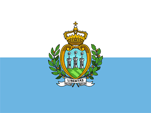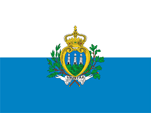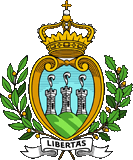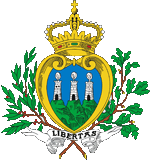San Marino |
|
|
|
| Übersicht – Contents: | |
Diese Seite ist Teil des Projektes
San Marino |
|
|
|
| Übersicht – Contents: | |
Flaggen – Flags: |
|
 |
Nationalflagge – national flag, Seitenverhältnis – ratio = 3:4, Quelle/Source, nach/by: Wikipedia (EN) |
 |
Staatsflagge – state flag, Seitenverhältnis – ratio = 3:4, Quelle/Source, nach/by: Wikipedia (EN), Zscout370, Public domain, via Wikimedia Commons |
historische Flaggen – historical Flags: |
|
 |
bis/to 2011, Nationalflagge – national flag, Seitenverhältnis – ratio = 3:4, Quelle/Source, nach/by: Wikipedia (EN) |
 |
bis/to 2011, |
| Die Flagge von San Marino wurde in ihrer heutigen Form zuletzt im Jahre 2011 mit einem Gesetz über die Flagge und das Wappen definiert. Das bis dato gültige Gesetz vom 06.04.1862 regelte das Wappen, erwähnte aber die Flagge nicht. Damit ist das Hellblau der Flagge seit 2011 eindeutig definiert, und zwar als Pantone 2915. Die Flagge zeigt zwei waagerechte Streifen in Weiß und Hellblau. Das Weiß steht für den Schnee auf dem Monte Titano und die Wolken, das Blau steht für den Himmel. Bereits im Jahr 1797 – Napoléon hatte gerade Italien erobert – wurden diese beiden Farben für die Kokarde und die Flagge San Marinos gewählt. Als Ursprung der Farben gilt das Wappen mit seinem blauen Himmel und den weißen Türmen. Die Staatsflagge trägt das Staatswappen in der Mitte. |
The flag of San Marino was last defined in its current form in 2011 with
a law on the flag and the coat of arms. The previously valid law of 6th of April in 1862
regulated the coat of arms, but did not mention the flag. Thus, the light
blue of the flag has been clearly defined since 2011, namely as Pantone
2915. The flag shows two horizontal stripes in white and light blue. The white stands for the snow on the Monte Titano and the clouds, the blue stands for the heaven. Already in 1797 – Napoléon had Italy even conquered – those two colours were choosen for the cockade and the flag of San Marino. As origin of the colours counts the coat of arms with its blue sky and the white towers. The state flag shows the coat of arms in the middle. |
| Quelle/Source: Wikipedia (EN), Volker Preuß | |
Wappen – Coat of Arms: |
|
 |
seit/since 2011, Wappen von San Marino – Coat of arms of San Marino, Quelle/Source: Zscout370, Public domain, via Wikimedia Commons |
 |
1862–2011, Wappen von San Marino – Coat of arms of San Marino, Quelle/Source: Fry1989, Public domain, via Wikimedia Commons |
| Das Wappen von San Marino wurde in ihrer heutigen Form zuletzt im Jahre 2011 mit einem Gesetz über die Flagge und das Wappen definiert. Bis dato galt das Gesetz vom 06.04.1862. Das Wappen ist seit dem 14. Jahrhundert bekannt. Es zeigt einen herzförmig eingefassten Schild: Vor blauem Himmel drei mit weißen Straußenfedern geschmückte weiße Türme auf jeweils einem Gipfel eines grünen Berges. Darüber eine Krone, links und rechts ein Lorbeer- und ein Eichenzweig. Unterhalb ein weißes Spruchband mit der Inschrift "Libertas" → "Freiheit". Die Krone steht für die Souveränität des Volkes – San Marino ist schon immer eine Republik gewesen. Die drei Türme stehen für die drei Burgen (Guaita, Cesta und Montale) auf den drei Gipfeln des Monte Titano. Sie verkörpern die Wehrhaftigkeit des Landes. Die weißen Straußenfedern auf den Türmen werden "pennae" (penna [lat.] = Feder) genannt, eine Anspielung auf das Apennin-Gebirge, in dem San Marino liegt. |
The coat of arms of San Marino was last defined in its current form in 2011
with a law on the flag and the coat of arms. Until then, the law of 6th of
April in 1862 was in force. The coat of arms has been known since the 14th
century. It shows a heart-shaped bordered shield: in front of a blue sky three white towers –
decorated with white ostrich feathers – on each one peaks of a green
mountain. Above that a crown, to the left and on the right one laurel and
one oak twig. Below a white banner with the inscription "Libertas" →
"Freedom". The crown stands for the sovereignty of the people – San Marino was always a republic. The three towers stand for the three castles (Guaita, Cesta and Montale) on the three peaks of Monte Titano. They embody the ability of the country to put up a fight. The white ostrich feathers on the towers are called "pennae" (penna [lat.] = feather), a hint at the Apennin Mountains in which San Marino is situated. |
| Quelle/Source: Die Welt der Flaggen, Flaggen Wappen Hymnen, Flaggen und Wappen der Welt, Volker Preuß | |
Landkarte – Map: |
Lage – Position: |
Landkarte des Landes – Map of the Country: |
| Zahlen und Fakten – Numbers and Facts: | |
|
|
|
|
|
|
|
|
|
|
|
|
|
|
|
|
|
|
| 301 · der
dalmatinische Christ und Steinmetz Marinus (Marino, Marinu), flieht mit
anderen Christen vor den Christenverfolgungen auf den Berg Monte Titano,
Entstehung einer Siedlung 400–410 · Invasionen der Goten in Italien 440–460 · Vandaleneinfälle in Italien 476 · Absetzung des letzten römischen Kaisers Romulus Augustulus, Ende des (West)Römischen Reiches, in Italien besteht bis 493 des Reich des Odoaker 434–540 · Eroberung Italiens durch Byzanz (Ostrom) 568–569 · Eroberung Italiens durch die Langobarden 600 · die Siedlung am Monte Titano trägt mit ihrer Verfassung einen republikanischen Charakter 800 · die Siedlung unterstellt sich dem Schutz der Grafen von Montefeltro 885 · eine Abtei "San Marino" (Heiliger Marinus) wird durch den Bischof von Rimini erstmals urkundlich erwähnt 10. Jhd. · die Siedlung San Marino errichtet eine Stadtmauer 1249 · der Schutz der der Grafen von Montefeltro endet (Geschlecht wahrscheinlich ausgestorben, Grafschaft endete) 1253 · die demokratische Verfassung von San Mariono wird amtlich niedergeschrieben 1400 · San Marino unterstellt sich dem Schutz der Herzöge von Urbino, bleibt aber ein unabhängiger Staat 1443 · San Marino besteht in den heutigen Grenzen 1599 · Verfassungsänderung 1796–1797 · Italienfeldzug Napoléons, San Marino verzichtet auf Gebietserweiterungen bei der Schrumpfung des Kirchenstaats, Frankreich erkennt San Marino als unabhängigen Staat an 1815 · Wiener Kongress, Neuordnung Europas nach der Ära Napoléon, die Unabhängigkeit von San Marino wird bestätigt 1862 · Zollunion und Schutzvertrag mit dem Königreich Italien 1914–1918 · Erster Weltkrieg, San Marino schließt sich der Entente an 1939 · Verfassungsänderung 1939–1945 · Zweiter Weltkrieg, San Marino ist zunächst neutral, erklärt aber dem Deutschen Reich 1944 den Krieg, daraufhin besetzen am 04.09.1944 deutsche Truppen San Marino, im Januar 1945 besetzen britische Truppen das Land 1945–1957 · sozialistisch-kommunistische Regierung, Enteignung der größten Grundbesitzer, Verstaatlichung der Wirtschaft 1957 · gescheiterter Putschversuch der Capitani reggenti, jedoch übernimmt eine bürgerliche Koalition die Regierung 1959 · Wahlen bestätigen die bürgerliche Koalition 1968 · der Schutzvertrag mit Italien endet 1978 · Wahlen, erneut sozialistisch-kommunistische Regierung 1986 · Sturz der sozialistisch-kommunistischen Regierung 1992 · San Marino wird Mitglied der UNO |
| 301 · the
Dalmatian christ and stonecutter Marinus (Marino, Marinu), flees with other
christs from the persecutions of christs onto the Titano Mountain (Monte
Titano), development of a smallholding 400–410 · invasions of the Goth in Italy 440–460 · Vandal's invasions in Italy 476 · dismissal of the last Roman emperor Romulus Augustulus, end of the (West)Roman Empire, on the area of the today's Italy exists until 493 the Empire of the Odoaker 434–540 · capture by Byzantium (East Rome) 568–569 · capture of Italy by the Langobards 600 · the smallholding at the Monte Titano has with its constitution a republican character 800 · the smallholding subordinates itself the protection of the Counts of Montefeltro 885 · an Abbey "San Marino" (Holy Marinus) is documentary mentioned for the first time by the Bishop of Rimini 10th cent. · the smallholding of San Marino builds a wall 1249 · the protection of the Counts of Montefeltro ends (lineage probably extincted, county ended) 1253 · the democratic constitution of San Mariono becomes officially written down 1400 · San Marino subordinates itself the protection of the Dukes of Urbino, but it stands as an independent state 1443 · San Marino consist within the today’s borders 1599 · changes of constitution 1796–1797 · Italy campaign of Napoléon, San Marino renounces for an enlargement of its territory on the occasion of the reduction of the Vatican State, France recognizes San Marino as independent state 1815 · Vienna Congress, reconfiguration of Europe after the era Napoléon, the independence of San Marino becomes confirmed 1862 · customs union and treaty of protection with the Kingdom of Italy 1914–1918 · First World War, San Marino joines the Entente 1939 · changes of constitution 1939–1945 · Second World War, San Marino is initially neutral, but declares the war to the German Empire in 1944, because of that German troops occupied San Marino on 4th of September 1944, in January 1945 British troops occupied the country 1945–1957 · socialistic-communist government, expropriation of the bigest landowners, nationalize of economy 1957 · failed attempt of a coup d’état of the Capitani reggenti, but a civil coalition takes over the power 1959 · elections confirm the civil coalition 1968 · the treaty of protection with Italy ends 1978 · elections, again socialistic-communist government 1986 · overthrow of the socialistic-communist government 1992 · San Marino joines the UNO |
| Quelle/Source: Atlas zur Geschichte, World Statesmen, Wikipedia (DE) |
| Der Name des Staates "San Marino" geht auf den Heiligen Marinus zurück, den legendären Gründer des Staates. Im Jahre 301 floh der dalmatinische Christ und Steinmetz Marinus (Marino, Marinu), mit anderen Christen vor den Christenverfolgungen auf den Berg Monte Titano. Sie gründeten dort eine Siedlung. | The Name of the state "San Marino" has its roots in the Holy Marinus, the legendary founder of the state. In the year 301 fled the Dalmatian christ and stonecutter Marinus (Marino, Marinu) with other christs from the persecutions of christs onto the Monte Titano. They established there a smallholding. |
| Quelle/Source: Handbuch der geographischen Namen, Volker Preuß | |